crossposted at StochasticDemocracy and DailyKos
These are the Labor Day election forecasts of Stochastic Democracy, in collaboration with Professor Wang of the Princeton Election Consortium. We have launched a new Election Forecasting System for House, Senate and Gubernatorial Elections and for tracking the Generic Ballot.
But before we discuss the forecasts in more detail, let me first get out of the way who we are and why you should listen to what we’re predicting:
Who we are (quoted from the FAQ at our site):
The team consists of David Shor, Harry Enten, and Rasmus Pianowski. David is a Math student currently visiting Princeton University as a Visiting Graduate Student. Harry is an undergraduate at Dartmouth and an intern at Pollster.com. Rasmus (that’s me) is a freshman at University of Hamburg, he has done political consulting and Media Outreach work for Montana congressional candidate Tyler Gernant.
The site is closely affiliated to Professor Wang’s Princeton Election Consortium.
Why you should listen to us
We have an outstanding track record.
In 2008, we correctly predicted the results of 49 of the 50 states in the Presidential Election, missing only Indiana (where we predicted that Obama had a 48% chance to win). We correctly predicted every single Senate and Gubernatorial election, and were off on the national popular vote for President by only 0.08%..
We also predicted that Obama would get 364 Electoral Votes, he ended up with 365 Electoral Votes.
In 2009, we correctly predicted the outcome of the 2009 Israeli Knesset election as well as 4 of the 5 notoriously hard to predict 2009 off-year elections- Pollster.com got only 2 correct, 538.com didn’t even put up predictions.
And we have a solid forecasting methodology that combines advanced statistical techniques with a huge polling database- and we do account for House Effects, so that you can be sure that our ratings aren’t swayed by Republican-leaning Rasmussen Reports polls too much.
Now on to the Forecasts.
Let me get out the bad news, and there is a lot of bad news, quickly:
The GOP is favored to take over the House, several Senate seats and Governorships.
For a complete list of election results, please visit Stochastic Democracy, here you’ll only find an analysis of several important races, maps and tables with results for select races.
Senate
As you can see, things look rather badly for the Democrats on the Senate front. While Republicans seem like relatively heavy underdogs to get a majority in the Senate, they at least will pick up several seats.
Arkansas, North Dakota, Indiana and Delaware are gone. With deficits of more than 15% in even the closest of these four races, it doesn’t make much sense to keep fighting except for helping down-ballot races.
In Pennsylvania, Joe Sestak has a fighting chance to mount yet another comeback, but so far his campaign hasn’t really taken off and with less than two months to go until the election he’s down against Pat Toomey by a bit less than 6%.
Colorado is close right now, even though the Republican candidate Ken Buck is ahead by a bit more than three points right now. The infighting among Colorado Conservatives in the Gubernatorial race might help Bennet to catch up.
In Florida the race is all but officially between incumbent Governor Charlie Crist, the Republican-turned Independent, and Tea Party favorite, Marco Rubio. The Democratic candidate Kendrick Meek has just about a 1 in 200 chance to win, while Rubio maintains a 4.5 point-advantage over Crist. The race is so unstable though that Crist can easily come back- or collapse.
In all other races, the incumbent party is currently favored (more or less) to retain their seats. For the Republicans, that means that Rob Portman (OH), Roy Blunt (MO), Rand Paul (KY), Richard Burr (NC) and the winner of the New Hampshire GOP primary (probably Kelly Ayotte) will more likely than not win.
The likely Democratic winners include Harry Reid (NV), Alexi Gianoullias (IL), Barbara Boxer (CA), Russ Feingold (WI)and Joe Manchin (WV), who is so heavily favored to retain the late Senator Byrd’s seat that this race doesn’t show up in the ‘most likely pickups’ table. On the other hand, Gianoullias, Reid and Feingold are all in races that could still go either way, even though they’re favored over their respective opponents right now.
Gubernatorial races
In the gubernatorial races, there are a few more highlights for Democrats, even though the bottom line looks rather bleak for Democrats here as well.
We are almost sure to lose six Governorships to the Republicans: In Kansas, Michigan, Iowa, Tennessee, Pennsylvania and Illinois. In every of those races except for Illinois, the Republican candidate is ahead by double digits, and most likely less than two months won’t be enough to close that gap.
On the bright side, we’re also almost certain to pick up the Governorships of Hawaii, Minnesota and Connecticut.
Maine is a race that doesn’t qualify as a ‘sure loss’ yet, but it doesn’t look good for Democrats, as Republican Paul LePage is leading Democrat Libby Mitchell by more than 8 points.
In the close battleground races it currently looks like Republican John Kasich is going to unseat incumbent Governor Ted Strickland of Ohio, Kasich is currently ahead by 4 points. The same could be said of New Mexico‘s gubernatorial race, where Republican Susana Martinez is favored to beat the Democratic Lieutenant Governor Diane Denish. Both of these races are close enough for Strickland and Denish to mount a comeback though.
Meanwhile, Democrats look like slight favorites in the gubernatorial elections of Florida, where Democrat Alex Sink leads the scandal-ridden Republican nominee Rick Scott, and in Rhode Island, where Democrat Frank Caprio is a slight favorite to win the governorship, edging former independent U.S. Senator Lincoln Chaffee. The Republican candidate is far behind.
Meanwhile, the true Toss-ups right now are in California (Brown vs. Whitman), Wisconsin (Barrett vs. Walker), and Oregon (Kitzhaber vs. Dudley). None of these races have a clear favorite right now, even though Barrett, Brown and Dudley would be slight favorites if the election was held today.
Democratic Governor Martin O’Malley (MD) and Republican Governor Rick Perry (TX)are both moderately favored to win their re-election bids against strong challengers, respectively former Governor Bob Ehrlich and Houston Mayor Bill White.
Incumbent party-candidates in New Hampshire (Lynch), Georgia (Deal), Massachusetts (Patrick) and in all races that aren’t listed here are favored to win their elections.
U.S. House
I don’t have enough space here to talk about all the interesting races as in the Senate and Governor sections, so let me just highlight the results of a couple of races that I know are dear to the netroots and of some especially close races:
In Florida-08 (Grayson-D), Alan Grayson is projected to lose to his challenger, Dan Webster, by 7.5%. He still has about a 25% chance to win reelection. Keep in mind that our model does not directly look at fundraising (it does look at Cook ratings though, and Cook does include fundraising in his ratings)- and Grayson has a gigantic warchest.
In Illinois-10 (open-R) Dan Seals is a slight favorite to finally become a U.S. Representative after twice unsuccessfully running against Mark Kirk.
In New York-20 (Murphy-D), Scott Murphy, who was elected with a strong Kossack phonebanking drive in the 2009 special election to replace Senator Gillibrand, looks like a slight favorite to win reelection. Bill Owens in NY-23 is a slight underdog though.
In Virginia-5 (Periello-D), red-district Progressive Tom Periello will almost certainly lose reelection.
In Idaho-1 (Minnick-D), the probably most conservative House Democrat Walt Minnick is projected to be a slight underdog in his reelection bid. You shouldn’t take this number too seriously though: This race is extreme. Minnick was, and the model can’t incorporate this, endorsed by the Tea Party Express and the Chamber of Commerce and praised by the Club for Growth, and the NRCC has already pulled resources from this district in the light of polls that show Minnick far ahead of his Republican opponent. Expect this number to shift as more polls come in, but right now our model isn’t convinced of Minnick’s staying power, as McCain won the district by a 61-35 margin in the 2008 Presidential Election while Minnick just barely beat a disliked Republican incumbent who won only 60% of his primary vote after winning a six-way GOP primary with 26% of the vote in 2006.
Races on knife’s edge: Here you can really make a difference
Julie Lassa (D) vs. Sean Duffy (R) (WI-07, Obey retiring)
Rep. Gerry Connoly (D) vs. Keith Firmian (R) (VA-11)
Rep. Phil Hare (D) vs. Robby Schilling (R) (IL-17)
Colleen Hanabusa (D) (likely) vs. Rep. Charles Djou (R) (HI-01)
Rep. Gabrielle Giffords (D) vs. Jesse Kelly (R) (AZ-08)
All of these 5 races are so close that every additional volunteer or donor might tip the race.
Summary:
Again, the bottom line isn’t pretty: The Democrats are likely to lose the House, several Senate seats and more Governorships than they will pick up.
Talking about continuing the gains that Democrats made in 2006 and 2008 is irrational now- what we can all do is pick a few campaigns and invest a lot of our time and put our best efforts into limiting our losses.
What the DCCC does– cutting incumbents that can’t win loose, might be a good strategy for private volunteers and donors as well.
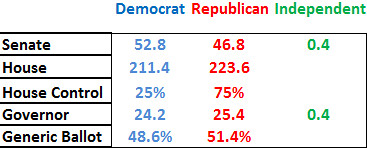
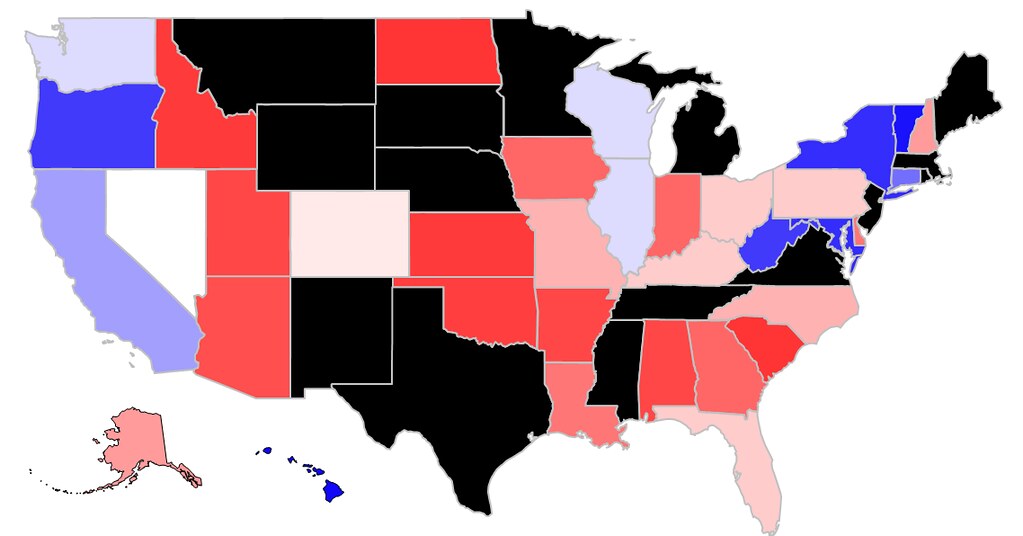
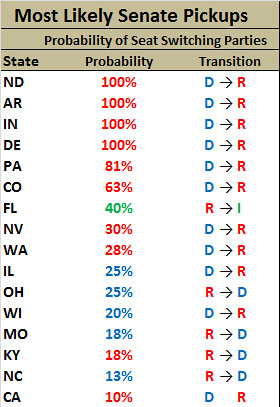
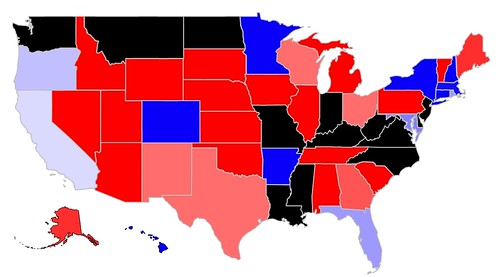
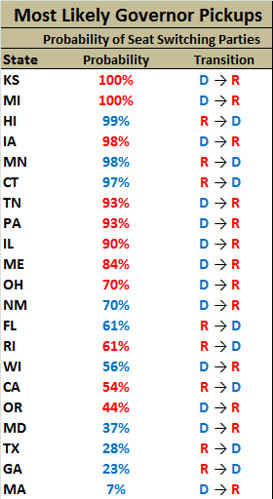


What kind of formula did you use?
Why is it 100% likely we lose AR-02 and only 98% likely we lose LA-03?
Something tells me you don’t take into account the personal popularity of certain candidates like Minnick. But I’m certainly glad to see that Bobby Bright isn’t here.
I got 48 states right, nailed the Senate and got the number of Democratic gains almost spot on. I see a net loss of 32 House seats right now. Senate and gubernatorials in the diary below.
The only published polls were by Republican pollsters. The most recent one was way off on the demographics of the likely voter pool and was in the field before a string of bad news for the Republican candidate, Brad Zaun. Local news radio and every local tv station carried the story about his ex-girlfriend having to call the police in 2001 to get him to back off. There are also stories about Zaun ignoring a court order to pay off a debt for years until just before he announced his run for Congress.
Again, all of the polls showing Zaun ahead were taken before any of this news broke, and all made very favorable (for Republicans) assumptions about the makeup of the electorate.
Meanwhile, there’s no sign yet that the NRCC will spend serious money for Zaun. They reserved air time in at least 40 districts, but not IA-03. Zaun is at a major financial disadvantage compared to Boswell.
The race is a tossup. There is no way Zaun has an 84 percent chance of beating Boswell, as per your analysis.
HI-01 is R to D, not D to R.
AL-05 is not a 99% likely pickup, it is a 99% likely hold.
AL-05 can’t switch from D to R since it is already in Republican hands.
-While I expect (hope) Mark Dayton to win the Minnesota Governor’s race I think a 98% chance is waaaaaay to optimistic.
Where is the polling on KS-03? I have not seen any polls of the race. How do you justify predicting an 87% likely Republican win in this very moderate district? 87% suggests a high degree of certainty. What do you base it on?
KS-03 includes the two most Democratic counties in Kansas (Wyandotte and Douglas) as well as a very moderate suburban county (Johnson County) that has been strongly trending away from the Republicans, especially since 2006. Obama won KS-03 in 2008. Democrat Dennis Moore has won re-election here very easily many times, proving that the district will elect and re-elect a Democrat that they are comfortable with.
You forgot to tell us how screwed we are in these races…
But I really have trouble giving your results that much credence when you give so many races 100% chances for one candidate.
Are you saying there’s 64% chance that district will flip from D to R ???
If so, I would find that somewhat hard to believe. Critz had 52.6% of the vote in the special, while Burns had 45.1%. Therefore, Burns % would have to go up by 3.8 or higher for him to win in Nov. [(52.6-45.1)/2] …
looking back at historical special elections, there have been extremely few circumstances in contested/high-profile races where the same two candidates were running, where the loser gained 3.8 from the special to the general election … I looked back over 20 years and couldn’t find a single real race …
a good example of this may be WI-1, where there was a special in May 1993. Peter Barca (D) won over Mark Neumann (R) by 50-49 (675 votes). In Nov. 1994 Neumann came back to beat Barca by 49.4-48.8 (1120 votes), so even though there was a party switch, the percentages didn’t really change that much …
so, unless 2010 has a much bigger GOP wave than 1994, I would find it hard to fathom a 64% chance that Burns wins this …
This race definitely isn’t a 100% guaranteed picked up for Republicans. The general election has barely started. It will be a much closer election than people are predicting.
MI-1 might flip, but 98% guaranteed? IL-17 should not be anywhere near 50-50.
The Senate picks and Governor picks are about where I would put them right now, but the House I think is a bit pessimistic. I think the major flaw of this analysis is twofold:
1.There is an over-reliance on the PVI, especially in districts where there has been little polling thus far. (ie: PA-10, GA-8) Tom Marino a 91% favorite over Chris Carney? That doesn’t jive with any piece of objective knowledge I’ve seen this cycle outside of PA-10’s PVI.
2.There doesn’t appear to be a large premium put on candidate quality. (ie: AZ-8, TX-17, NH-1). I mean really, does anybody believe that there is a 98% chance of Chet Edwards losing? I don’t. Nor do I think TN-8 is a guaranteed pickup for Team Red, Roy Herron’s strength as a candidate is underrated here.
sidebar: Those that have disagreed over my take about the Dems losing lots of seats in the Southeast have to be pulling their hair out over these rankings. Even I’ve never had Jim Marshall or Suzanne Kosmas losing.
Interesting analysis and thanks for the work. While it sucks to see the results you have done your best to be unbiased and take any emotion out of the equation so it is what is. A few comments that I have.
1) Yes it sucks but Tom Perriello is toast. I live in Northern Virginia and did canvassing for him this weekend and the amount of people that said “I voted for him in 2008 but no way this year” is hard to figure how he wins having only won by 800 votes in 2008.
2) I have to agree with the poster above regarding IA-3. I don’t see how Leonard Boswell only has a 16% chance of retaining his seat. His opponent has had some pretty bad publicity lately and is very much underfunded. Boswell is 78 and will likely retire if he wins. The district could be chopped in redistricting.
3) I realize that it is a nasty climate but Chet Edwards has only a 2% chance of surviving? This guy has been targeted time after time and yet still survives. Tom Delay targeted 5 people with his 2004 redistricting plan and all but he have been defeated. His opponent is not a top tier recruit either.
4) I really don’t see Jesse Kelly as a viable candidate against Gabby Giffords. District is pretty moderate as it is primarily Tucson and Giffords fits the mold. Kelly is inexperienced and very much underfunded. Paton would have been a very tough challenger but thankfully Kelly helped out team blue.
5) I agree with you about supporting Julie Lassa as that is a swing district that typically goes Dem that we will need to hold but I strongly disagree about Gerry Connoly and VA-11. I live nearby the district and this is one area that is very quickly moving from team red to team blue. Connoly is also well known in the district as the former chairman of the Fairfax County Supervisors and it is VERY expensive to get your message out given that it covers Washington DC’s TV market. Dems are having trouble in blue collar districts not in white collar districts like this. I really don’t see this one as anything less than a team blue 7 point win.
6) Hard to do this work and everyone can complain about it but it is a baseline right now that can and will change (hopefully towards team blue).
This isnt quite a done deal. Well it is for Quinn but not for Brady. Mostly because Quinn is so clueless that he makes the dems look awful. Illinoians wont vote for a Republicans because the last rep governor is currently incarcerated. I think its time for a change and that illinois voters will cast thier ballots for independent Scott Lee Cohen .
You open your post by bragging about your “outstanding track record.”
But you then proceed to confuse me entirely by posting two contradictory statements about your 2008 predictions.
First, you say that “In 2008, we correctly predicted the results of 49 of the 50 states in the Presidential Election, missing only Indiana (where we predicted that Obama had a 48% chance to win).”
Then you go on to say “We also predicted that Obama would get 364 Electoral Votes, he ended up with 365 Electoral Votes.”
Okay, that is a neat math trick, but which one did you actually predict? How did you get to 364 electoral votes if you got Indiana wrong and every other state right. Where did those extra ten electoral votes come from?
—
But beyond that nit-picking (but annoying) point, my larger question goes to this: what were you predicting at the beginning of September 2008, not what were you predicting on election eve.
If we want to judge your forecasting model and the relevance of the forecast you are making now, the fairest thing is to compare it the forecasts you were making at a comparable point in time.
So, how exactly did your September 6, 2008 predictions stack up against the November 2008 election results? Was your track record so “outstanding” then?
—
Not asking this to be combative, but simply to make sure we’re being upfront about the value and limitations of forecasts made fully 2 months before any election.
Did you adjust for the how recently it went Republican (this Summer) and why (3 way race with two Dems, so 40% was enough)? Basically, you’re projecting a 10% swing to the Republicans in a matter of months, with candidates they already know, and just voted on.
The American Future Fund, a right-wing 501(c)4 organization, just released a batch of Iowa polls (pdf file). In IA-03, they found the generic Congressional ballot at 40 R/39 D. They found Boswell leading Zaun 48 percent to 39 percent. The “certain to vote” head to head toplines were Boswell 47.3 percent, Zaun 41.3 percent. Their party breakdown (I assume this was for the likely voters was 42%D, 36%R, 20% independent or third party).
Now, this is just a snapshot, and some key figures in the American Future Fund backed a different Republican (Jim Gibbons) in the primary against Zaun. So, I’m not saying Boswell is certainly ahead. But I strongly disagree with your contention that Zaun has an 84% chance of winning IA-03.
http://fivethirtyeight.blogs.n…
Nate’s a lot smarter than I am but I just don’t think things are that bad.